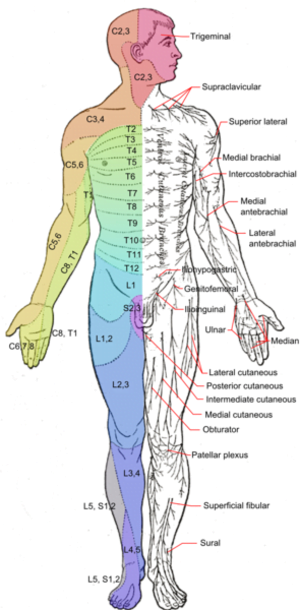The nervous system is composed of a network of fibers responsible for sending chemical and electrical signals to cells within the body. The nervous system and the endocrine system rely heavily on one another as chemical messengers are often produced by components within the endocrine system. The nervous system is composed of two parts; the central nervous system and the peripheral nervous system. It may seem as though there are several different nervous systems, but these are all just the collective parts of the nervous system.
Central Nervous System (CNS)
The central nervous system contains the brain, which is surrounded and protected by the cranium, and the spinal cord, which is surrounded and protected by the vertebrae of the spinal column. The central nervous system uis directly responsible for the way that the body behaves. The brain is made up of three important regions; the cerebrum, the cerebellum and the medulla oblongata. The cerebellum and the medulla oblongata are the parts of the brain responsible for the actions of the central nervous system.
Peripheral Nervous System (PNS)
The peripheral nervous system is composed of all parts of the nervous system with the exception of the brain and spinal cord. The peripheral nervous system contains the nervous fibers that most people envision when they think of the nervous system. These nerve fibers stem from the central nervous system and are spread throughout the body. A single nerve is composed of many nerve fibers and swelled areas known as ganglia. The peripheral nervous system is the connection between the central nervous system and the rest of the body. The peripheral nervous system is divided into two divisions; motor and sensory.
The sensory division, also known as the afferent division, is responsible for the passage of chemical and electrical signals to and from the central nervous system, thus alerting the central nervous system to stimuli. This division can be even further divided into two divisions; the somatic sensory division and the visceral sensory division. The somatic sensory division is responsoble for transmitting signals from recieved in the muscles, skin, joints and bones. The visceral sensory division is responsible for transmitting signals from the viscera, or organs, such as the heart, lungs, stomach and bladder.
The motor division, also known as the efferent division is responsible for transmitting messages from the central nervous system to cells located with the muscles and glands. These muscles and glands are them able to respond to these signals, carrying out the intended response. These cells that carry out actions as commanded by the central nervous system are known as effectors. Just as the sensory division is subdivided, the motor division is also subdivided into the somatic motor division and the visceral motor division. The somatic motor division is responsible for the transmission of chemical and electrical signals to and from the skeletal muscles while the visceral motor division, also known as the autonomic nervous system) is responsible for transmitting signals to the organs and glands. The somatic motor division is divided even further into the sympathetic division and the parasympathetic division. The sympathetic division prepares the body to take action (such as a sudden release of adrenaline that causes the heart to pound) and the parasympathetic division acts on the body the opposite way; calming the body and returning it to it’s normal state (such as slowing the heart rate).
Somatic Nervous System
The two subdivisions of the sensory division and the motor division, the somatic sensory division and the somatic motor division are collectively referred to as the somatic nervous system. Although they are truly part of the sensory division and motor division of the peripheral nervous system, they are often thought of separately.
The somatic nervous system is responsible for the movement and functioning of the voluntary muscles. All five senses, and the reception of all external stimuli is controlled by the somatic nervous system.
References
Saladin, Kenneth S.. Anatomy & physiology: the unity of form and function. 5th ed. Dubuque: McGraw-Hill, 2010. Print.
The Peripheral Nervous System
What is the central nervous system?
What is the peripheral nervous system?
What is the somatic nervous system?





